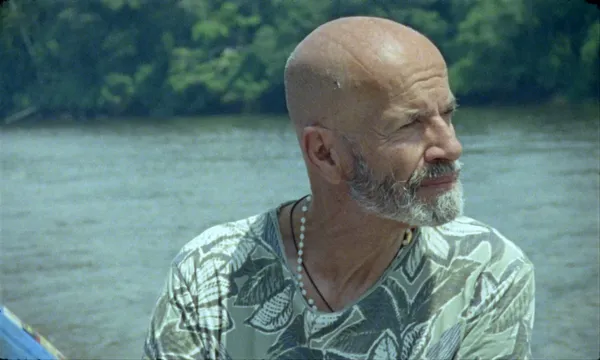Eye For Film >> Movies >> Anamocot (2025) Film Review
Anamocot
Reviewed by: Amber Wilkinson

Documentaries don’t necessarily need an arc but some sort of structure helps and while Marie Voignier’s Anamocot touches on interesting subjects, including the enduring shadows of colonialism and patriarchal dominance, it is so loosely constructed that it starts to fall apart.
The setting is Cameroon. The central African country has seen more than its fair share of colonialism, having been ruled by Germany, Britain and France at various points in its history. Frenchman Michel Ballot is visiting a forested area of the country, and not for the first time. On a quest that recalls Scotland’s old favourite the Loch Ness Monster, he has spent 20 years searching for a creature known locally as the Mokélé-Mbembé.

Why Ballot is particularly fixated on this is just one of many elements of Voignier’s film that goes steadfastly unexplored. Where a little light quizzing of him would have neatly set the scene, instead the observational approach works against the director, slowing down proceedings and making it hard to see the wood for the trees. Ballot has enlisted the help of various local men, some of whom tell him he has to first be initiated by a local genie – the Anamacot of the title – although, of course all these things come at a price.
Elsewhere in the village, we see the women working on a piece of collective land and operating a savings system to help one another. They also talk of Anamocot, pointedly noting that they were the ones who found the genie but that it has been appropriated by the men. All of this is interesting up to a point but there’s a lack of explanatory glue to hold it together. We only meet the men and women separately, so there’s no insight into the interactions between them about the Frenchman, so we’re left to glean whatever we can via the various snatches of conversations.
The spectre of colonialism looms larger as the film progresses, with one local noting that, “We know Europeans don’t like to leave empty handed”, but it's hard to know what Voignier really wants her audience to take away from this and, because Ballot is never questioned directly, there’s no firm sense of what his motives are either.
Some of those involved appear to be true believers in terms of the mystic elements involved, including, at least potentially, Ballot himself, but because nobody really explains what they think of the creature, beyond its physical appearance, it’s hard to even get a full grip of its concept, let alone anything physical. Leaving things open to interpretation can be admirable but there’s a sense of Voignier’s filmmaking being infected by Ballot’s approach, which is just to set a camera up and leave it running in the hopes that something fascinating will walk by.
Reviewed on: 11 Apr 2025
















